Earth-Cycler: A Proposal for a Food Waste Recycling Business Venture
VerifiedAdded on 2021/06/16
|10
|2836
|50
Report
AI Summary
This opportunity proposal outlines the business plan for Earth-Cycler, a recycling machine designed for homes and small businesses to manage food waste effectively. The proposal addresses the significant global issue of food waste, highlighting its environmental and economic impacts. The report details the product's analysis, targeting homes and small retailers as key customers. It emphasizes the project's viability, competitive landscape, and the capabilities of the team. The business model canvas and value proposition are presented, showcasing how Earth-Cycler offers solutions for efficient food waste management and promotes environmental awareness. The proposal includes validation of the project through existing research and justification for its implementation, along with potential challenges and mitigation strategies. The Earth-Cycler aims to reduce methane emissions, provide compost for gardening, and promote sustainable waste management practices. The project is presented to potential investors, and the proposal includes a minimum viable product strategy to test market viability.
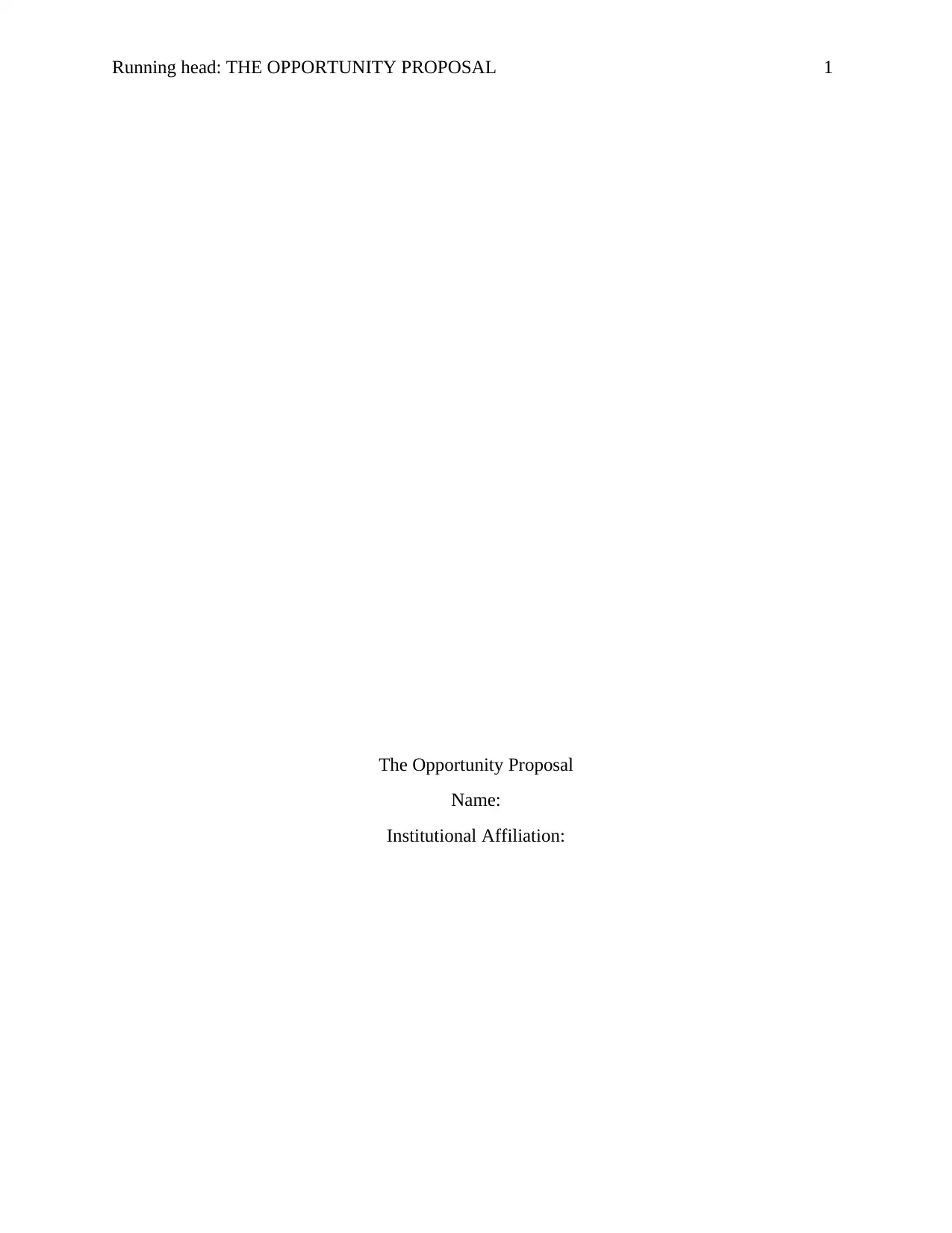
Running head: THE OPPORTUNITY PROPOSAL 1
The Opportunity Proposal
Name:
Institutional Affiliation:
The Opportunity Proposal
Name:
Institutional Affiliation:
Paraphrase This Document
Need a fresh take? Get an instant paraphrase of this document with our AI Paraphraser
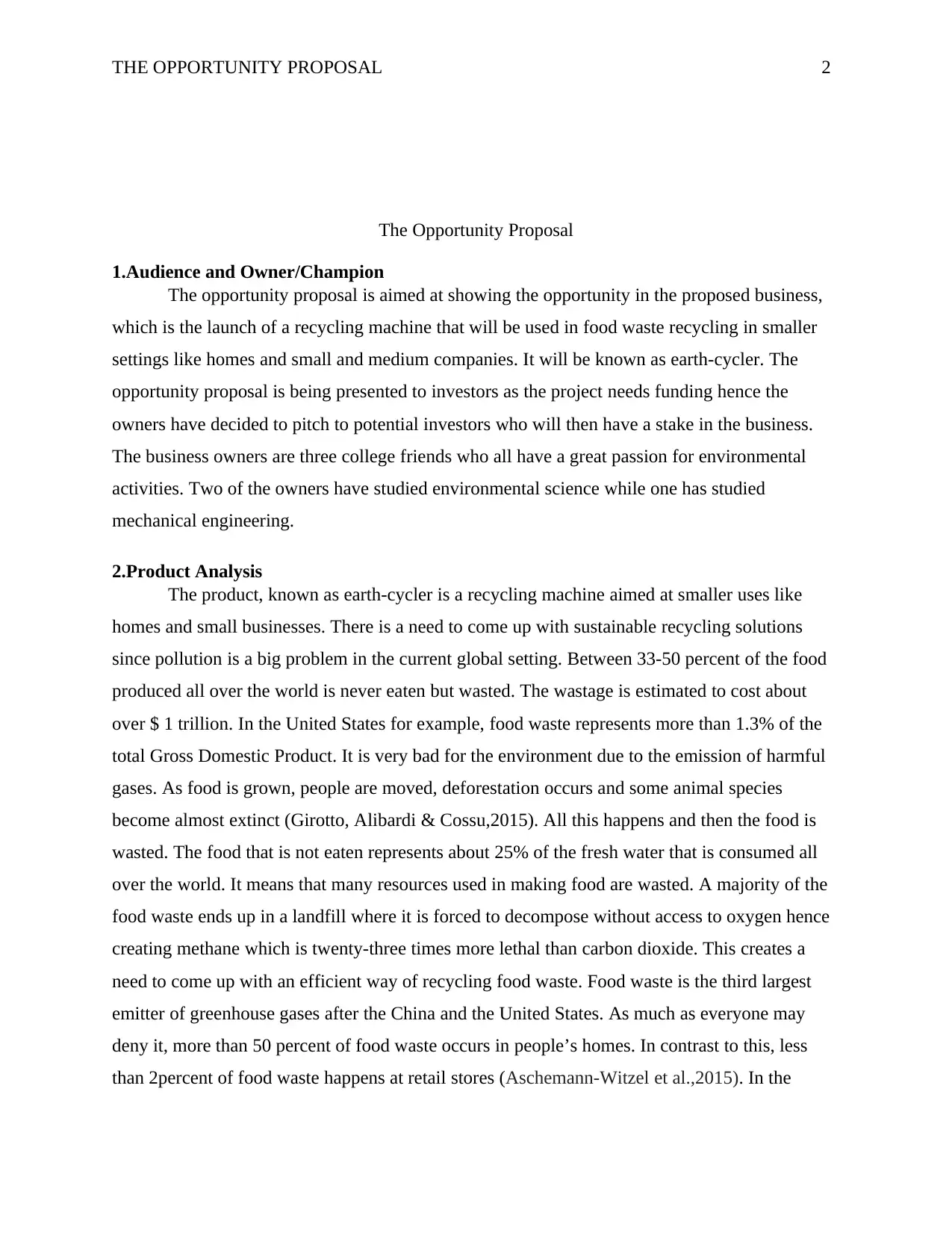
THE OPPORTUNITY PROPOSAL 2
The Opportunity Proposal
1.Audience and Owner/Champion
The opportunity proposal is aimed at showing the opportunity in the proposed business,
which is the launch of a recycling machine that will be used in food waste recycling in smaller
settings like homes and small and medium companies. It will be known as earth-cycler. The
opportunity proposal is being presented to investors as the project needs funding hence the
owners have decided to pitch to potential investors who will then have a stake in the business.
The business owners are three college friends who all have a great passion for environmental
activities. Two of the owners have studied environmental science while one has studied
mechanical engineering.
2.Product Analysis
The product, known as earth-cycler is a recycling machine aimed at smaller uses like
homes and small businesses. There is a need to come up with sustainable recycling solutions
since pollution is a big problem in the current global setting. Between 33-50 percent of the food
produced all over the world is never eaten but wasted. The wastage is estimated to cost about
over $ 1 trillion. In the United States for example, food waste represents more than 1.3% of the
total Gross Domestic Product. It is very bad for the environment due to the emission of harmful
gases. As food is grown, people are moved, deforestation occurs and some animal species
become almost extinct (Girotto, Alibardi & Cossu,2015). All this happens and then the food is
wasted. The food that is not eaten represents about 25% of the fresh water that is consumed all
over the world. It means that many resources used in making food are wasted. A majority of the
food waste ends up in a landfill where it is forced to decompose without access to oxygen hence
creating methane which is twenty-three times more lethal than carbon dioxide. This creates a
need to come up with an efficient way of recycling food waste. Food waste is the third largest
emitter of greenhouse gases after the China and the United States. As much as everyone may
deny it, more than 50 percent of food waste occurs in people’s homes. In contrast to this, less
than 2percent of food waste happens at retail stores (Aschemann-Witzel et al.,2015). In the
The Opportunity Proposal
1.Audience and Owner/Champion
The opportunity proposal is aimed at showing the opportunity in the proposed business,
which is the launch of a recycling machine that will be used in food waste recycling in smaller
settings like homes and small and medium companies. It will be known as earth-cycler. The
opportunity proposal is being presented to investors as the project needs funding hence the
owners have decided to pitch to potential investors who will then have a stake in the business.
The business owners are three college friends who all have a great passion for environmental
activities. Two of the owners have studied environmental science while one has studied
mechanical engineering.
2.Product Analysis
The product, known as earth-cycler is a recycling machine aimed at smaller uses like
homes and small businesses. There is a need to come up with sustainable recycling solutions
since pollution is a big problem in the current global setting. Between 33-50 percent of the food
produced all over the world is never eaten but wasted. The wastage is estimated to cost about
over $ 1 trillion. In the United States for example, food waste represents more than 1.3% of the
total Gross Domestic Product. It is very bad for the environment due to the emission of harmful
gases. As food is grown, people are moved, deforestation occurs and some animal species
become almost extinct (Girotto, Alibardi & Cossu,2015). All this happens and then the food is
wasted. The food that is not eaten represents about 25% of the fresh water that is consumed all
over the world. It means that many resources used in making food are wasted. A majority of the
food waste ends up in a landfill where it is forced to decompose without access to oxygen hence
creating methane which is twenty-three times more lethal than carbon dioxide. This creates a
need to come up with an efficient way of recycling food waste. Food waste is the third largest
emitter of greenhouse gases after the China and the United States. As much as everyone may
deny it, more than 50 percent of food waste occurs in people’s homes. In contrast to this, less
than 2percent of food waste happens at retail stores (Aschemann-Witzel et al.,2015). In the
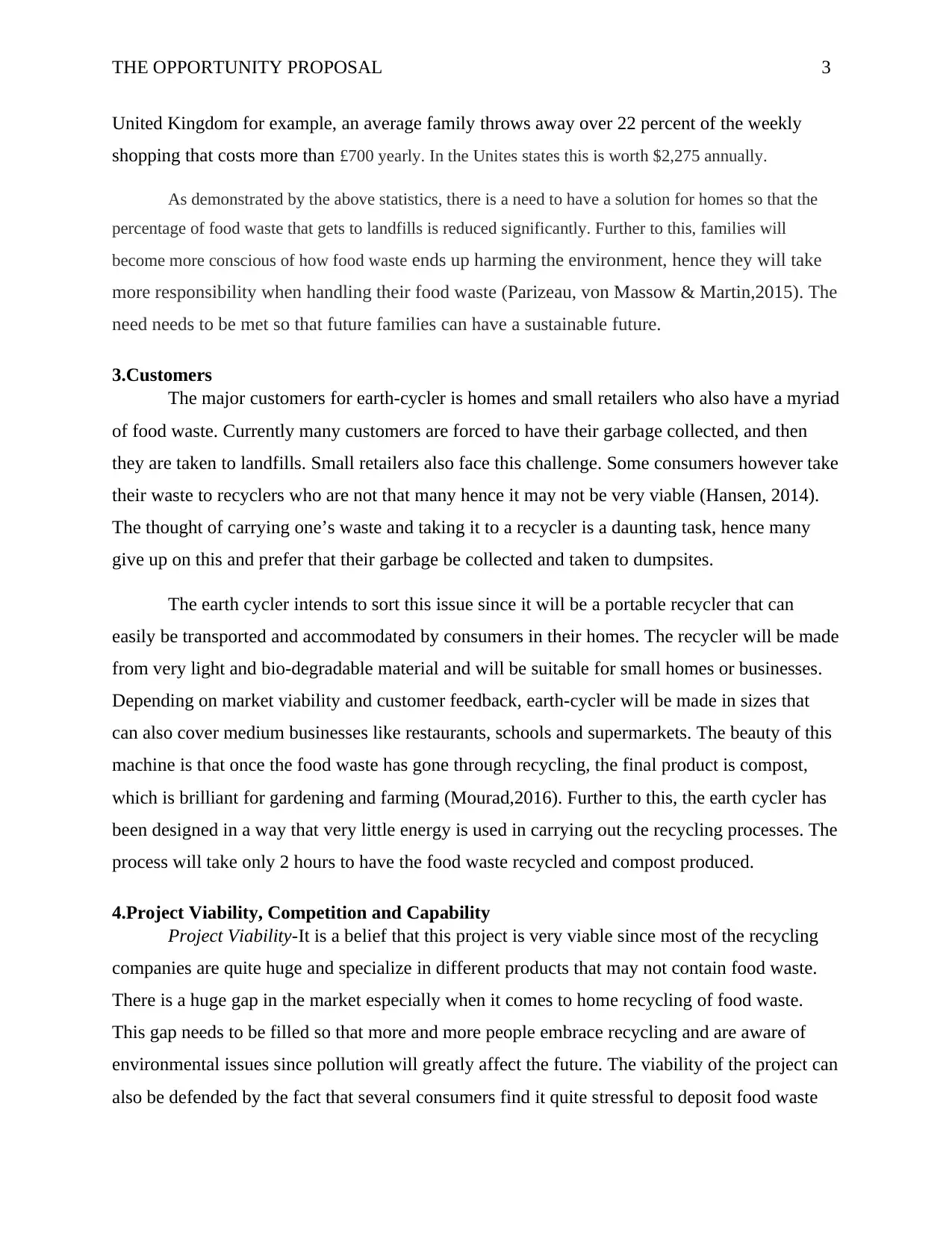
THE OPPORTUNITY PROPOSAL 3
United Kingdom for example, an average family throws away over 22 percent of the weekly
shopping that costs more than £700 yearly. In the Unites states this is worth $2,275 annually.
As demonstrated by the above statistics, there is a need to have a solution for homes so that the
percentage of food waste that gets to landfills is reduced significantly. Further to this, families will
become more conscious of how food waste ends up harming the environment, hence they will take
more responsibility when handling their food waste (Parizeau, von Massow & Martin,2015). The
need needs to be met so that future families can have a sustainable future.
3.Customers
The major customers for earth-cycler is homes and small retailers who also have a myriad
of food waste. Currently many customers are forced to have their garbage collected, and then
they are taken to landfills. Small retailers also face this challenge. Some consumers however take
their waste to recyclers who are not that many hence it may not be very viable (Hansen, 2014).
The thought of carrying one’s waste and taking it to a recycler is a daunting task, hence many
give up on this and prefer that their garbage be collected and taken to dumpsites.
The earth cycler intends to sort this issue since it will be a portable recycler that can
easily be transported and accommodated by consumers in their homes. The recycler will be made
from very light and bio-degradable material and will be suitable for small homes or businesses.
Depending on market viability and customer feedback, earth-cycler will be made in sizes that
can also cover medium businesses like restaurants, schools and supermarkets. The beauty of this
machine is that once the food waste has gone through recycling, the final product is compost,
which is brilliant for gardening and farming (Mourad,2016). Further to this, the earth cycler has
been designed in a way that very little energy is used in carrying out the recycling processes. The
process will take only 2 hours to have the food waste recycled and compost produced.
4.Project Viability, Competition and Capability
Project Viability-It is a belief that this project is very viable since most of the recycling
companies are quite huge and specialize in different products that may not contain food waste.
There is a huge gap in the market especially when it comes to home recycling of food waste.
This gap needs to be filled so that more and more people embrace recycling and are aware of
environmental issues since pollution will greatly affect the future. The viability of the project can
also be defended by the fact that several consumers find it quite stressful to deposit food waste
United Kingdom for example, an average family throws away over 22 percent of the weekly
shopping that costs more than £700 yearly. In the Unites states this is worth $2,275 annually.
As demonstrated by the above statistics, there is a need to have a solution for homes so that the
percentage of food waste that gets to landfills is reduced significantly. Further to this, families will
become more conscious of how food waste ends up harming the environment, hence they will take
more responsibility when handling their food waste (Parizeau, von Massow & Martin,2015). The
need needs to be met so that future families can have a sustainable future.
3.Customers
The major customers for earth-cycler is homes and small retailers who also have a myriad
of food waste. Currently many customers are forced to have their garbage collected, and then
they are taken to landfills. Small retailers also face this challenge. Some consumers however take
their waste to recyclers who are not that many hence it may not be very viable (Hansen, 2014).
The thought of carrying one’s waste and taking it to a recycler is a daunting task, hence many
give up on this and prefer that their garbage be collected and taken to dumpsites.
The earth cycler intends to sort this issue since it will be a portable recycler that can
easily be transported and accommodated by consumers in their homes. The recycler will be made
from very light and bio-degradable material and will be suitable for small homes or businesses.
Depending on market viability and customer feedback, earth-cycler will be made in sizes that
can also cover medium businesses like restaurants, schools and supermarkets. The beauty of this
machine is that once the food waste has gone through recycling, the final product is compost,
which is brilliant for gardening and farming (Mourad,2016). Further to this, the earth cycler has
been designed in a way that very little energy is used in carrying out the recycling processes. The
process will take only 2 hours to have the food waste recycled and compost produced.
4.Project Viability, Competition and Capability
Project Viability-It is a belief that this project is very viable since most of the recycling
companies are quite huge and specialize in different products that may not contain food waste.
There is a huge gap in the market especially when it comes to home recycling of food waste.
This gap needs to be filled so that more and more people embrace recycling and are aware of
environmental issues since pollution will greatly affect the future. The viability of the project can
also be defended by the fact that several consumers find it quite stressful to deposit food waste
⊘ This is a preview!⊘
Do you want full access?
Subscribe today to unlock all pages.

Trusted by 1+ million students worldwide
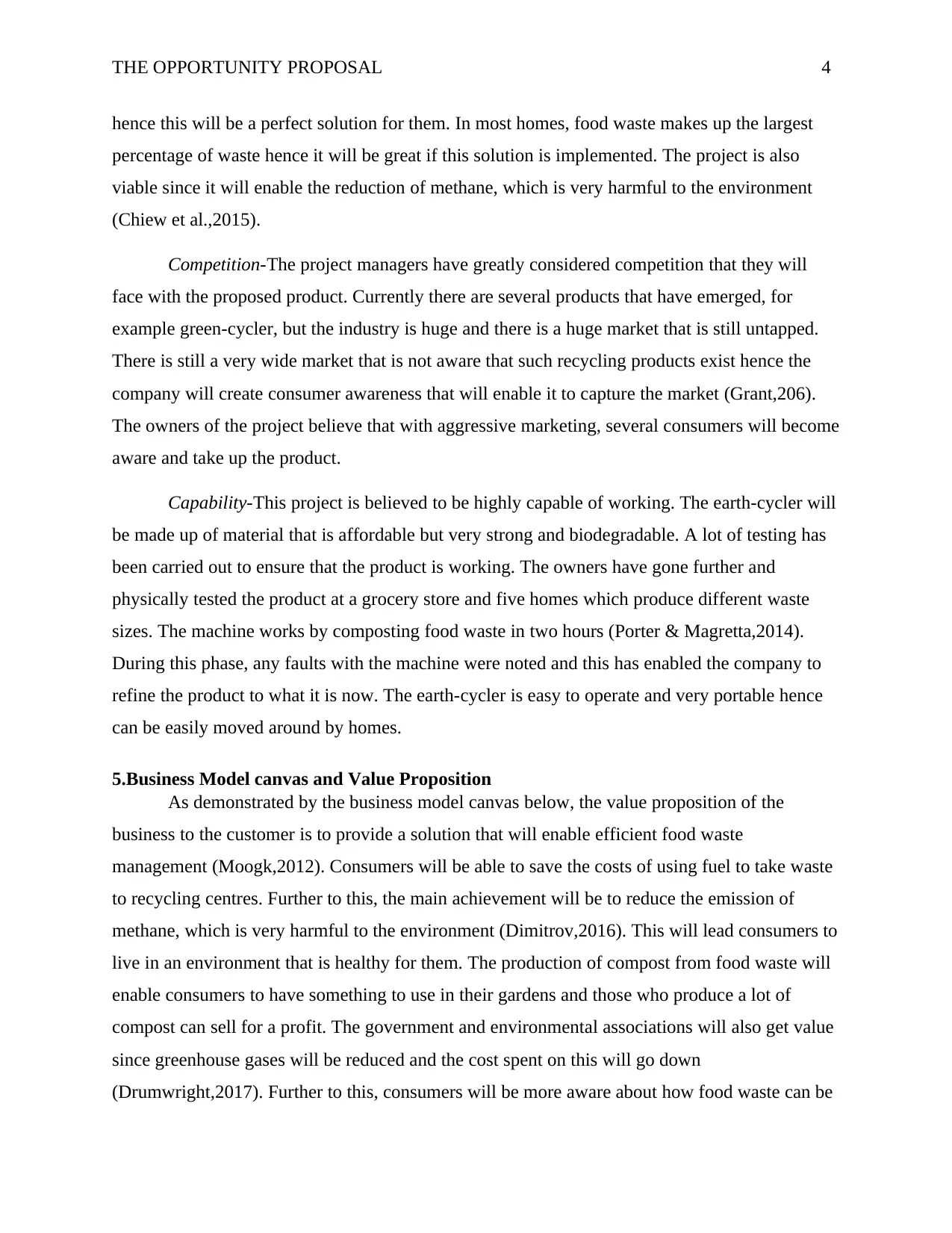
THE OPPORTUNITY PROPOSAL 4
hence this will be a perfect solution for them. In most homes, food waste makes up the largest
percentage of waste hence it will be great if this solution is implemented. The project is also
viable since it will enable the reduction of methane, which is very harmful to the environment
(Chiew et al.,2015).
Competition-The project managers have greatly considered competition that they will
face with the proposed product. Currently there are several products that have emerged, for
example green-cycler, but the industry is huge and there is a huge market that is still untapped.
There is still a very wide market that is not aware that such recycling products exist hence the
company will create consumer awareness that will enable it to capture the market (Grant,206).
The owners of the project believe that with aggressive marketing, several consumers will become
aware and take up the product.
Capability-This project is believed to be highly capable of working. The earth-cycler will
be made up of material that is affordable but very strong and biodegradable. A lot of testing has
been carried out to ensure that the product is working. The owners have gone further and
physically tested the product at a grocery store and five homes which produce different waste
sizes. The machine works by composting food waste in two hours (Porter & Magretta,2014).
During this phase, any faults with the machine were noted and this has enabled the company to
refine the product to what it is now. The earth-cycler is easy to operate and very portable hence
can be easily moved around by homes.
5.Business Model canvas and Value Proposition
As demonstrated by the business model canvas below, the value proposition of the
business to the customer is to provide a solution that will enable efficient food waste
management (Moogk,2012). Consumers will be able to save the costs of using fuel to take waste
to recycling centres. Further to this, the main achievement will be to reduce the emission of
methane, which is very harmful to the environment (Dimitrov,2016). This will lead consumers to
live in an environment that is healthy for them. The production of compost from food waste will
enable consumers to have something to use in their gardens and those who produce a lot of
compost can sell for a profit. The government and environmental associations will also get value
since greenhouse gases will be reduced and the cost spent on this will go down
(Drumwright,2017). Further to this, consumers will be more aware about how food waste can be
hence this will be a perfect solution for them. In most homes, food waste makes up the largest
percentage of waste hence it will be great if this solution is implemented. The project is also
viable since it will enable the reduction of methane, which is very harmful to the environment
(Chiew et al.,2015).
Competition-The project managers have greatly considered competition that they will
face with the proposed product. Currently there are several products that have emerged, for
example green-cycler, but the industry is huge and there is a huge market that is still untapped.
There is still a very wide market that is not aware that such recycling products exist hence the
company will create consumer awareness that will enable it to capture the market (Grant,206).
The owners of the project believe that with aggressive marketing, several consumers will become
aware and take up the product.
Capability-This project is believed to be highly capable of working. The earth-cycler will
be made up of material that is affordable but very strong and biodegradable. A lot of testing has
been carried out to ensure that the product is working. The owners have gone further and
physically tested the product at a grocery store and five homes which produce different waste
sizes. The machine works by composting food waste in two hours (Porter & Magretta,2014).
During this phase, any faults with the machine were noted and this has enabled the company to
refine the product to what it is now. The earth-cycler is easy to operate and very portable hence
can be easily moved around by homes.
5.Business Model canvas and Value Proposition
As demonstrated by the business model canvas below, the value proposition of the
business to the customer is to provide a solution that will enable efficient food waste
management (Moogk,2012). Consumers will be able to save the costs of using fuel to take waste
to recycling centres. Further to this, the main achievement will be to reduce the emission of
methane, which is very harmful to the environment (Dimitrov,2016). This will lead consumers to
live in an environment that is healthy for them. The production of compost from food waste will
enable consumers to have something to use in their gardens and those who produce a lot of
compost can sell for a profit. The government and environmental associations will also get value
since greenhouse gases will be reduced and the cost spent on this will go down
(Drumwright,2017). Further to this, consumers will be more aware about how food waste can be
Paraphrase This Document
Need a fresh take? Get an instant paraphrase of this document with our AI Paraphraser
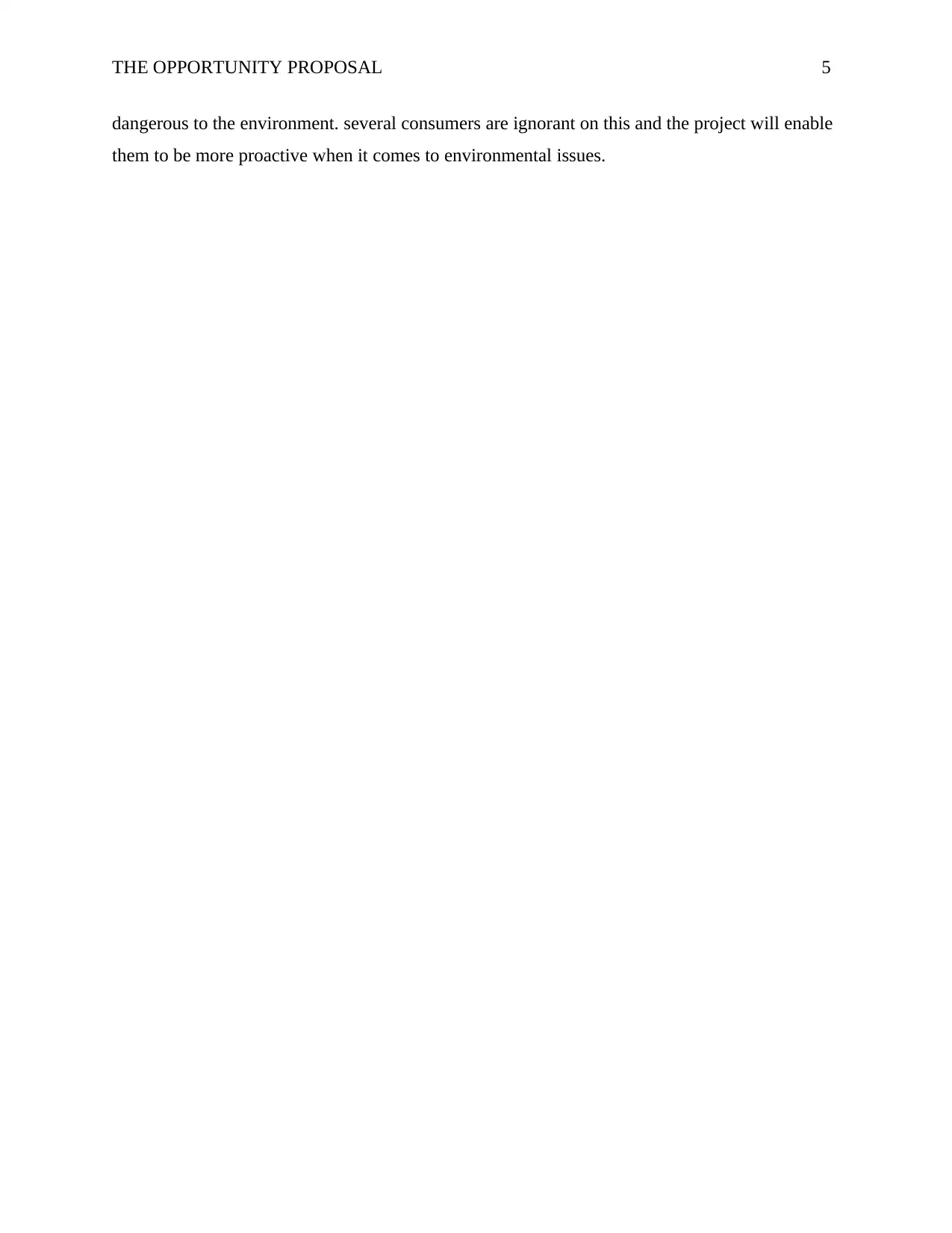
THE OPPORTUNITY PROPOSAL 5
dangerous to the environment. several consumers are ignorant on this and the project will enable
them to be more proactive when it comes to environmental issues.
dangerous to the environment. several consumers are ignorant on this and the project will enable
them to be more proactive when it comes to environmental issues.
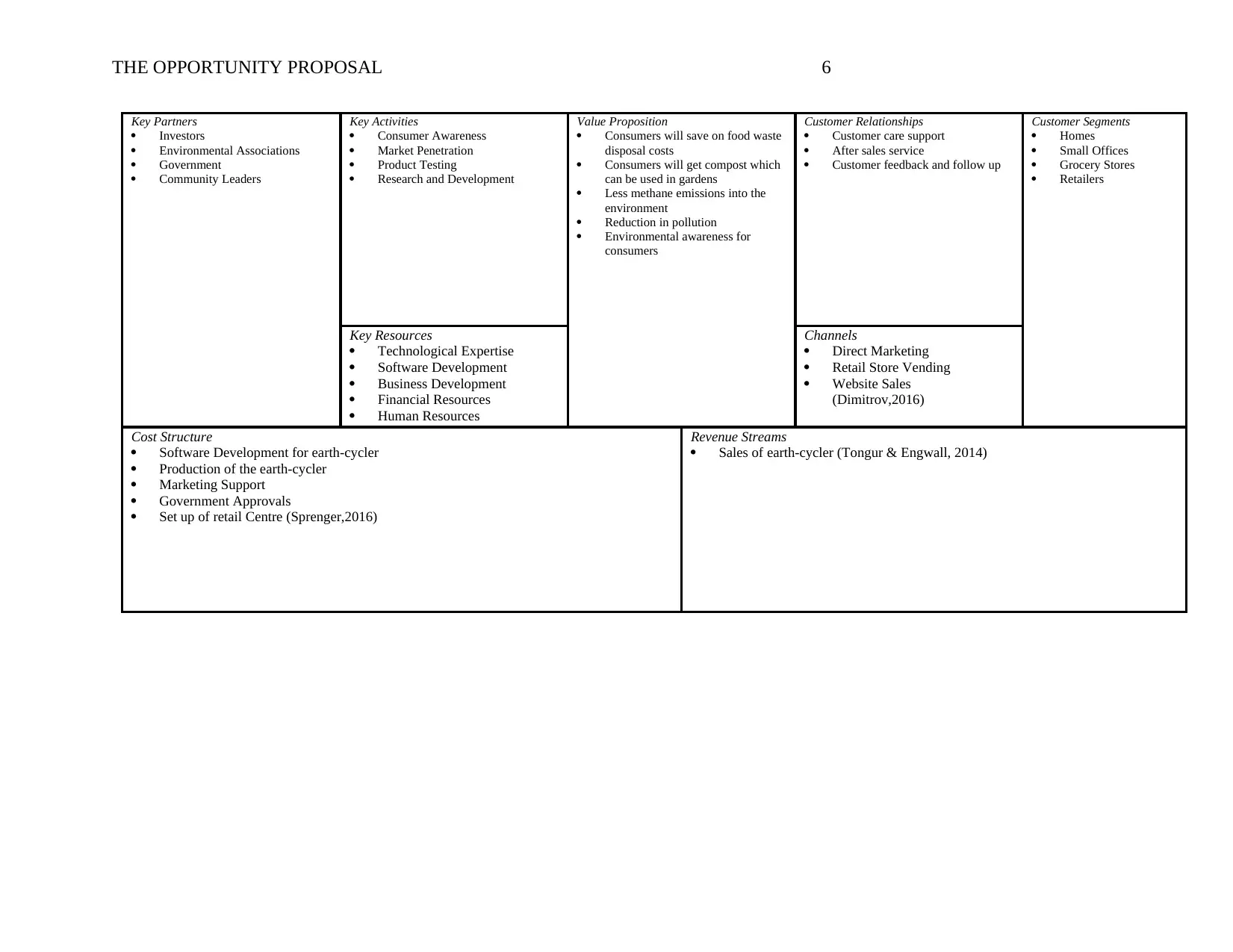
THE OPPORTUNITY PROPOSAL 6
Key Partners
Investors
Environmental Associations
Government
Community Leaders
Key Activities
Consumer Awareness
Market Penetration
Product Testing
Research and Development
Value Proposition
Consumers will save on food waste
disposal costs
Consumers will get compost which
can be used in gardens
Less methane emissions into the
environment
Reduction in pollution
Environmental awareness for
consumers
Customer Relationships
Customer care support
After sales service
Customer feedback and follow up
Customer Segments
Homes
Small Offices
Grocery Stores
Retailers
Key Resources
Technological Expertise
Software Development
Business Development
Financial Resources
Human Resources
Channels
Direct Marketing
Retail Store Vending
Website Sales
(Dimitrov,2016)
Cost Structure
Software Development for earth-cycler
Production of the earth-cycler
Marketing Support
Government Approvals
Set up of retail Centre (Sprenger,2016)
Revenue Streams
Sales of earth-cycler (Tongur & Engwall, 2014)
Key Partners
Investors
Environmental Associations
Government
Community Leaders
Key Activities
Consumer Awareness
Market Penetration
Product Testing
Research and Development
Value Proposition
Consumers will save on food waste
disposal costs
Consumers will get compost which
can be used in gardens
Less methane emissions into the
environment
Reduction in pollution
Environmental awareness for
consumers
Customer Relationships
Customer care support
After sales service
Customer feedback and follow up
Customer Segments
Homes
Small Offices
Grocery Stores
Retailers
Key Resources
Technological Expertise
Software Development
Business Development
Financial Resources
Human Resources
Channels
Direct Marketing
Retail Store Vending
Website Sales
(Dimitrov,2016)
Cost Structure
Software Development for earth-cycler
Production of the earth-cycler
Marketing Support
Government Approvals
Set up of retail Centre (Sprenger,2016)
Revenue Streams
Sales of earth-cycler (Tongur & Engwall, 2014)
⊘ This is a preview!⊘
Do you want full access?
Subscribe today to unlock all pages.

Trusted by 1+ million students worldwide
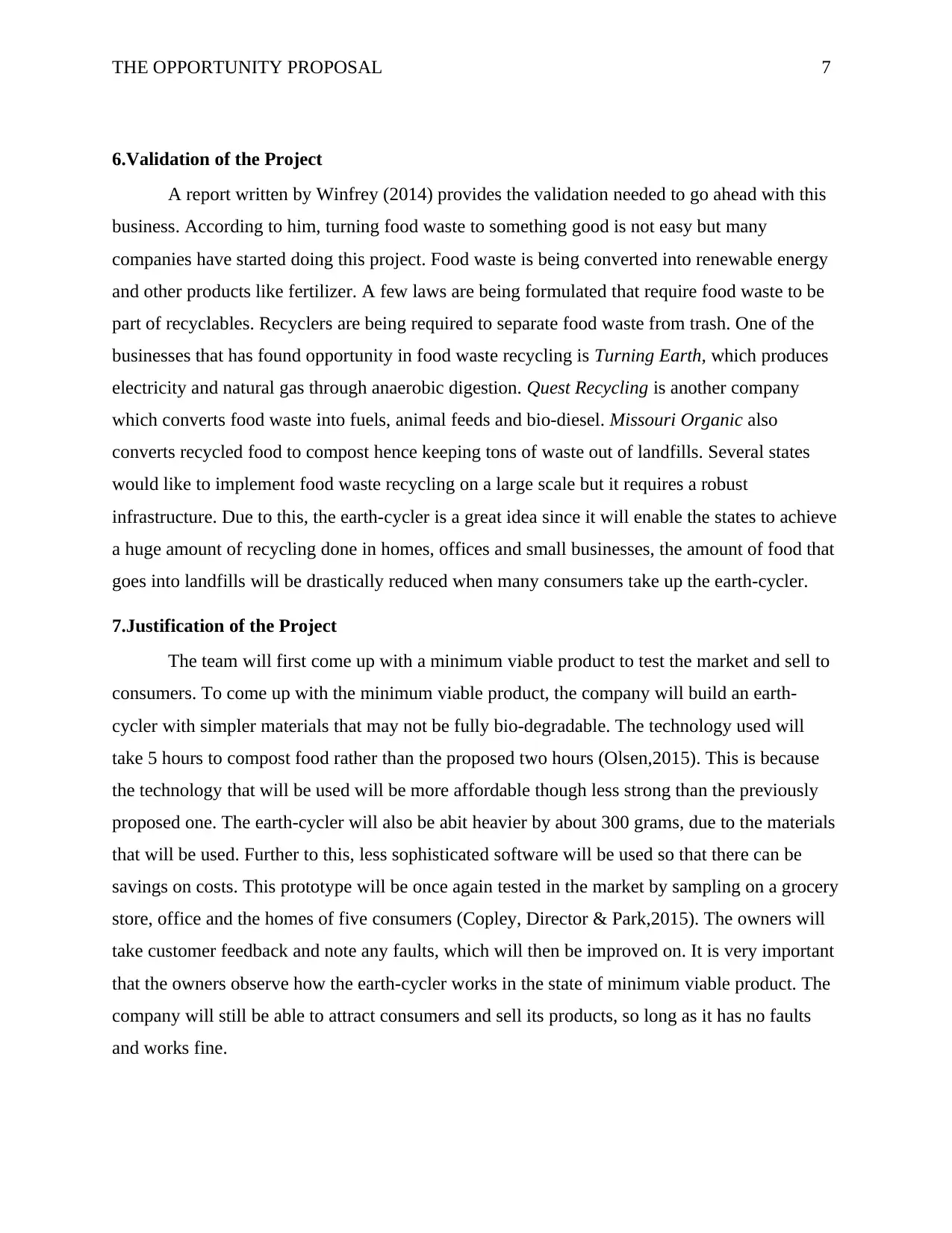
THE OPPORTUNITY PROPOSAL 7
6.Validation of the Project
A report written by Winfrey (2014) provides the validation needed to go ahead with this
business. According to him, turning food waste to something good is not easy but many
companies have started doing this project. Food waste is being converted into renewable energy
and other products like fertilizer. A few laws are being formulated that require food waste to be
part of recyclables. Recyclers are being required to separate food waste from trash. One of the
businesses that has found opportunity in food waste recycling is Turning Earth, which produces
electricity and natural gas through anaerobic digestion. Quest Recycling is another company
which converts food waste into fuels, animal feeds and bio-diesel. Missouri Organic also
converts recycled food to compost hence keeping tons of waste out of landfills. Several states
would like to implement food waste recycling on a large scale but it requires a robust
infrastructure. Due to this, the earth-cycler is a great idea since it will enable the states to achieve
a huge amount of recycling done in homes, offices and small businesses, the amount of food that
goes into landfills will be drastically reduced when many consumers take up the earth-cycler.
7.Justification of the Project
The team will first come up with a minimum viable product to test the market and sell to
consumers. To come up with the minimum viable product, the company will build an earth-
cycler with simpler materials that may not be fully bio-degradable. The technology used will
take 5 hours to compost food rather than the proposed two hours (Olsen,2015). This is because
the technology that will be used will be more affordable though less strong than the previously
proposed one. The earth-cycler will also be abit heavier by about 300 grams, due to the materials
that will be used. Further to this, less sophisticated software will be used so that there can be
savings on costs. This prototype will be once again tested in the market by sampling on a grocery
store, office and the homes of five consumers (Copley, Director & Park,2015). The owners will
take customer feedback and note any faults, which will then be improved on. It is very important
that the owners observe how the earth-cycler works in the state of minimum viable product. The
company will still be able to attract consumers and sell its products, so long as it has no faults
and works fine.
6.Validation of the Project
A report written by Winfrey (2014) provides the validation needed to go ahead with this
business. According to him, turning food waste to something good is not easy but many
companies have started doing this project. Food waste is being converted into renewable energy
and other products like fertilizer. A few laws are being formulated that require food waste to be
part of recyclables. Recyclers are being required to separate food waste from trash. One of the
businesses that has found opportunity in food waste recycling is Turning Earth, which produces
electricity and natural gas through anaerobic digestion. Quest Recycling is another company
which converts food waste into fuels, animal feeds and bio-diesel. Missouri Organic also
converts recycled food to compost hence keeping tons of waste out of landfills. Several states
would like to implement food waste recycling on a large scale but it requires a robust
infrastructure. Due to this, the earth-cycler is a great idea since it will enable the states to achieve
a huge amount of recycling done in homes, offices and small businesses, the amount of food that
goes into landfills will be drastically reduced when many consumers take up the earth-cycler.
7.Justification of the Project
The team will first come up with a minimum viable product to test the market and sell to
consumers. To come up with the minimum viable product, the company will build an earth-
cycler with simpler materials that may not be fully bio-degradable. The technology used will
take 5 hours to compost food rather than the proposed two hours (Olsen,2015). This is because
the technology that will be used will be more affordable though less strong than the previously
proposed one. The earth-cycler will also be abit heavier by about 300 grams, due to the materials
that will be used. Further to this, less sophisticated software will be used so that there can be
savings on costs. This prototype will be once again tested in the market by sampling on a grocery
store, office and the homes of five consumers (Copley, Director & Park,2015). The owners will
take customer feedback and note any faults, which will then be improved on. It is very important
that the owners observe how the earth-cycler works in the state of minimum viable product. The
company will still be able to attract consumers and sell its products, so long as it has no faults
and works fine.
Paraphrase This Document
Need a fresh take? Get an instant paraphrase of this document with our AI Paraphraser
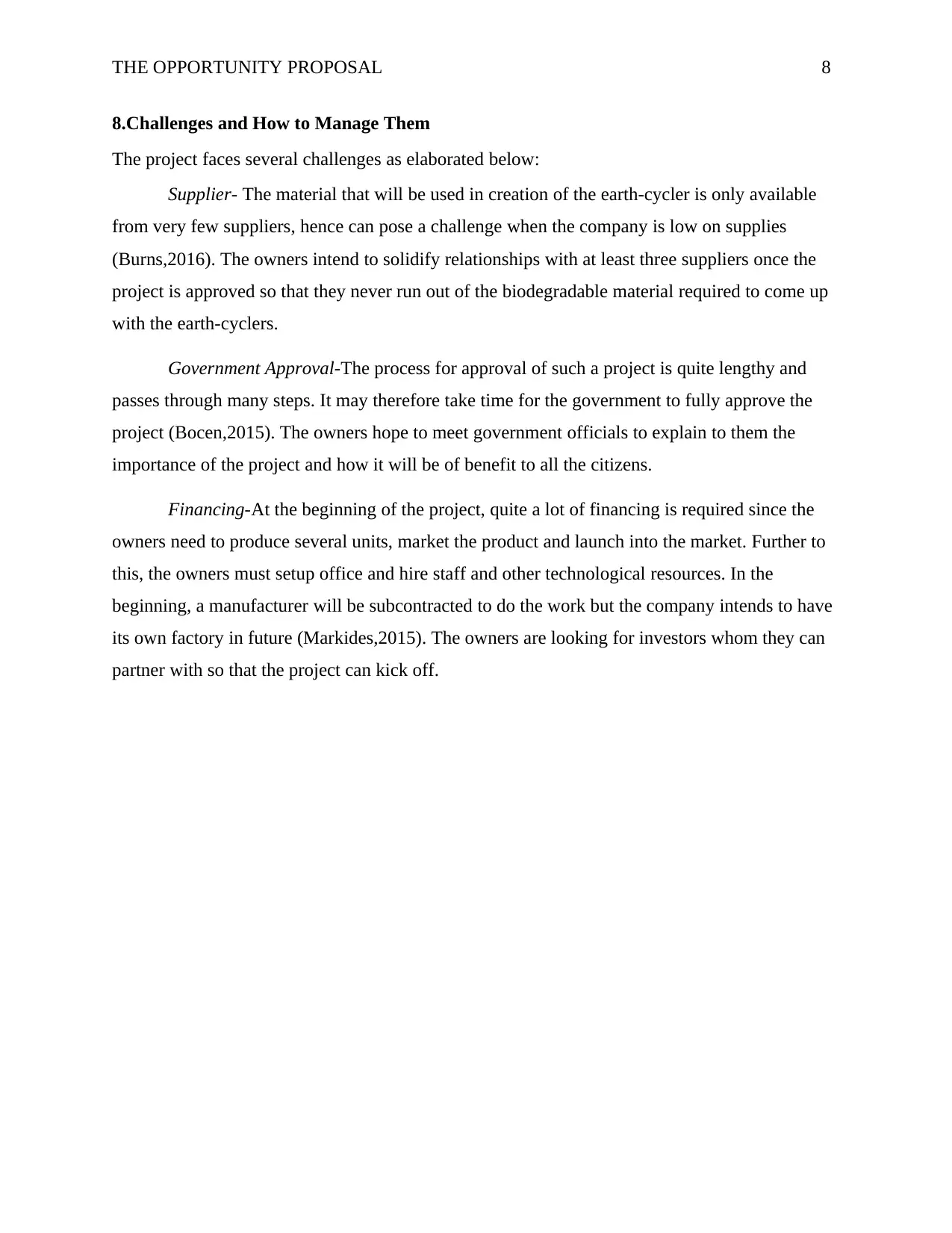
THE OPPORTUNITY PROPOSAL 8
8.Challenges and How to Manage Them
The project faces several challenges as elaborated below:
Supplier- The material that will be used in creation of the earth-cycler is only available
from very few suppliers, hence can pose a challenge when the company is low on supplies
(Burns,2016). The owners intend to solidify relationships with at least three suppliers once the
project is approved so that they never run out of the biodegradable material required to come up
with the earth-cyclers.
Government Approval-The process for approval of such a project is quite lengthy and
passes through many steps. It may therefore take time for the government to fully approve the
project (Bocen,2015). The owners hope to meet government officials to explain to them the
importance of the project and how it will be of benefit to all the citizens.
Financing-At the beginning of the project, quite a lot of financing is required since the
owners need to produce several units, market the product and launch into the market. Further to
this, the owners must setup office and hire staff and other technological resources. In the
beginning, a manufacturer will be subcontracted to do the work but the company intends to have
its own factory in future (Markides,2015). The owners are looking for investors whom they can
partner with so that the project can kick off.
8.Challenges and How to Manage Them
The project faces several challenges as elaborated below:
Supplier- The material that will be used in creation of the earth-cycler is only available
from very few suppliers, hence can pose a challenge when the company is low on supplies
(Burns,2016). The owners intend to solidify relationships with at least three suppliers once the
project is approved so that they never run out of the biodegradable material required to come up
with the earth-cyclers.
Government Approval-The process for approval of such a project is quite lengthy and
passes through many steps. It may therefore take time for the government to fully approve the
project (Bocen,2015). The owners hope to meet government officials to explain to them the
importance of the project and how it will be of benefit to all the citizens.
Financing-At the beginning of the project, quite a lot of financing is required since the
owners need to produce several units, market the product and launch into the market. Further to
this, the owners must setup office and hire staff and other technological resources. In the
beginning, a manufacturer will be subcontracted to do the work but the company intends to have
its own factory in future (Markides,2015). The owners are looking for investors whom they can
partner with so that the project can kick off.
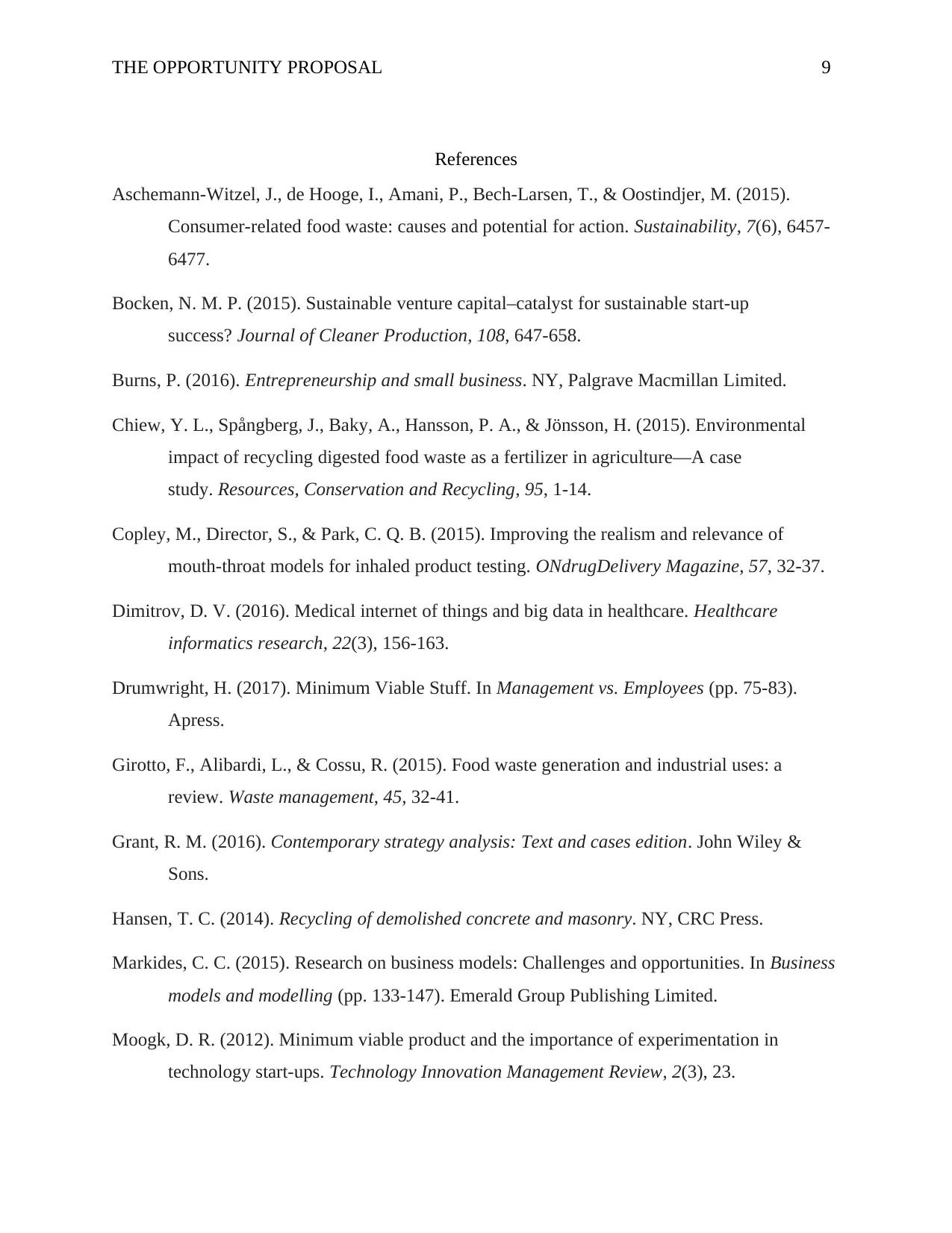
THE OPPORTUNITY PROPOSAL 9
References
Aschemann-Witzel, J., de Hooge, I., Amani, P., Bech-Larsen, T., & Oostindjer, M. (2015).
Consumer-related food waste: causes and potential for action. Sustainability, 7(6), 6457-
6477.
Bocken, N. M. P. (2015). Sustainable venture capital–catalyst for sustainable start-up
success? Journal of Cleaner Production, 108, 647-658.
Burns, P. (2016). Entrepreneurship and small business. NY, Palgrave Macmillan Limited.
Chiew, Y. L., Spångberg, J., Baky, A., Hansson, P. A., & Jönsson, H. (2015). Environmental
impact of recycling digested food waste as a fertilizer in agriculture—A case
study. Resources, Conservation and Recycling, 95, 1-14.
Copley, M., Director, S., & Park, C. Q. B. (2015). Improving the realism and relevance of
mouth-throat models for inhaled product testing. ONdrugDelivery Magazine, 57, 32-37.
Dimitrov, D. V. (2016). Medical internet of things and big data in healthcare. Healthcare
informatics research, 22(3), 156-163.
Drumwright, H. (2017). Minimum Viable Stuff. In Management vs. Employees (pp. 75-83).
Apress.
Girotto, F., Alibardi, L., & Cossu, R. (2015). Food waste generation and industrial uses: a
review. Waste management, 45, 32-41.
Grant, R. M. (2016). Contemporary strategy analysis: Text and cases edition. John Wiley &
Sons.
Hansen, T. C. (2014). Recycling of demolished concrete and masonry. NY, CRC Press.
Markides, C. C. (2015). Research on business models: Challenges and opportunities. In Business
models and modelling (pp. 133-147). Emerald Group Publishing Limited.
Moogk, D. R. (2012). Minimum viable product and the importance of experimentation in
technology start-ups. Technology Innovation Management Review, 2(3), 23.
References
Aschemann-Witzel, J., de Hooge, I., Amani, P., Bech-Larsen, T., & Oostindjer, M. (2015).
Consumer-related food waste: causes and potential for action. Sustainability, 7(6), 6457-
6477.
Bocken, N. M. P. (2015). Sustainable venture capital–catalyst for sustainable start-up
success? Journal of Cleaner Production, 108, 647-658.
Burns, P. (2016). Entrepreneurship and small business. NY, Palgrave Macmillan Limited.
Chiew, Y. L., Spångberg, J., Baky, A., Hansson, P. A., & Jönsson, H. (2015). Environmental
impact of recycling digested food waste as a fertilizer in agriculture—A case
study. Resources, Conservation and Recycling, 95, 1-14.
Copley, M., Director, S., & Park, C. Q. B. (2015). Improving the realism and relevance of
mouth-throat models for inhaled product testing. ONdrugDelivery Magazine, 57, 32-37.
Dimitrov, D. V. (2016). Medical internet of things and big data in healthcare. Healthcare
informatics research, 22(3), 156-163.
Drumwright, H. (2017). Minimum Viable Stuff. In Management vs. Employees (pp. 75-83).
Apress.
Girotto, F., Alibardi, L., & Cossu, R. (2015). Food waste generation and industrial uses: a
review. Waste management, 45, 32-41.
Grant, R. M. (2016). Contemporary strategy analysis: Text and cases edition. John Wiley &
Sons.
Hansen, T. C. (2014). Recycling of demolished concrete and masonry. NY, CRC Press.
Markides, C. C. (2015). Research on business models: Challenges and opportunities. In Business
models and modelling (pp. 133-147). Emerald Group Publishing Limited.
Moogk, D. R. (2012). Minimum viable product and the importance of experimentation in
technology start-ups. Technology Innovation Management Review, 2(3), 23.
⊘ This is a preview!⊘
Do you want full access?
Subscribe today to unlock all pages.

Trusted by 1+ million students worldwide
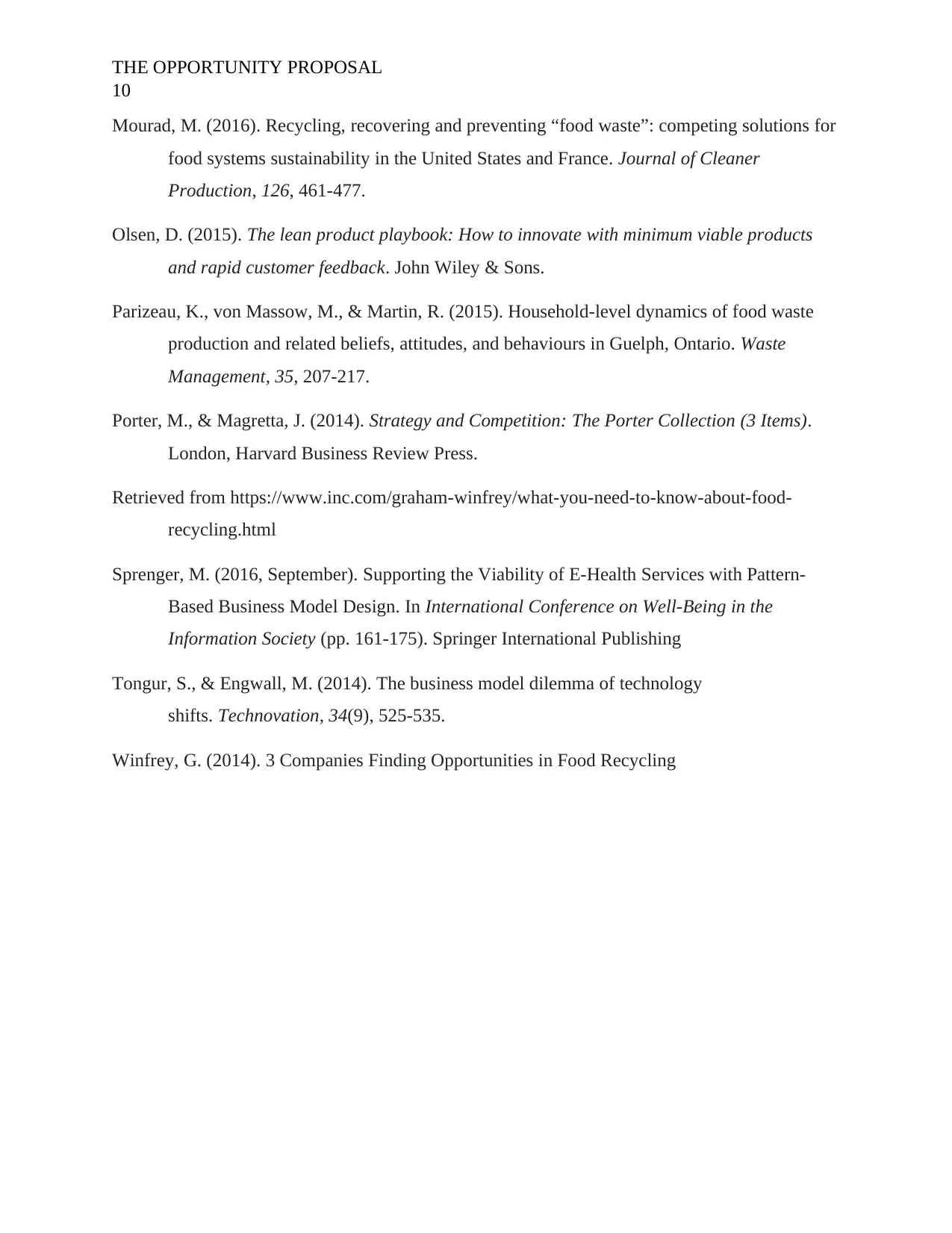
THE OPPORTUNITY PROPOSAL
10
Mourad, M. (2016). Recycling, recovering and preventing “food waste”: competing solutions for
food systems sustainability in the United States and France. Journal of Cleaner
Production, 126, 461-477.
Olsen, D. (2015). The lean product playbook: How to innovate with minimum viable products
and rapid customer feedback. John Wiley & Sons.
Parizeau, K., von Massow, M., & Martin, R. (2015). Household-level dynamics of food waste
production and related beliefs, attitudes, and behaviours in Guelph, Ontario. Waste
Management, 35, 207-217.
Porter, M., & Magretta, J. (2014). Strategy and Competition: The Porter Collection (3 Items).
London, Harvard Business Review Press.
Retrieved from https://www.inc.com/graham-winfrey/what-you-need-to-know-about-food-
recycling.html
Sprenger, M. (2016, September). Supporting the Viability of E-Health Services with Pattern-
Based Business Model Design. In International Conference on Well-Being in the
Information Society (pp. 161-175). Springer International Publishing
Tongur, S., & Engwall, M. (2014). The business model dilemma of technology
shifts. Technovation, 34(9), 525-535.
Winfrey, G. (2014). 3 Companies Finding Opportunities in Food Recycling
10
Mourad, M. (2016). Recycling, recovering and preventing “food waste”: competing solutions for
food systems sustainability in the United States and France. Journal of Cleaner
Production, 126, 461-477.
Olsen, D. (2015). The lean product playbook: How to innovate with minimum viable products
and rapid customer feedback. John Wiley & Sons.
Parizeau, K., von Massow, M., & Martin, R. (2015). Household-level dynamics of food waste
production and related beliefs, attitudes, and behaviours in Guelph, Ontario. Waste
Management, 35, 207-217.
Porter, M., & Magretta, J. (2014). Strategy and Competition: The Porter Collection (3 Items).
London, Harvard Business Review Press.
Retrieved from https://www.inc.com/graham-winfrey/what-you-need-to-know-about-food-
recycling.html
Sprenger, M. (2016, September). Supporting the Viability of E-Health Services with Pattern-
Based Business Model Design. In International Conference on Well-Being in the
Information Society (pp. 161-175). Springer International Publishing
Tongur, S., & Engwall, M. (2014). The business model dilemma of technology
shifts. Technovation, 34(9), 525-535.
Winfrey, G. (2014). 3 Companies Finding Opportunities in Food Recycling
1 out of 10
Related Documents
Your All-in-One AI-Powered Toolkit for Academic Success.
+13062052269
info@desklib.com
Available 24*7 on WhatsApp / Email
![[object Object]](/_next/static/media/star-bottom.7253800d.svg)
Unlock your academic potential
Copyright © 2020–2025 A2Z Services. All Rights Reserved. Developed and managed by ZUCOL.





